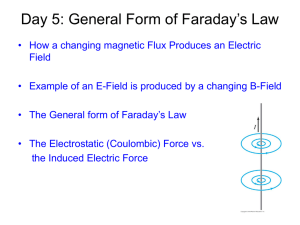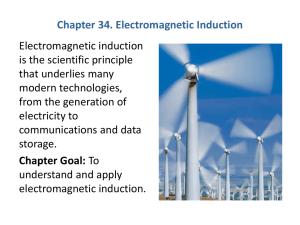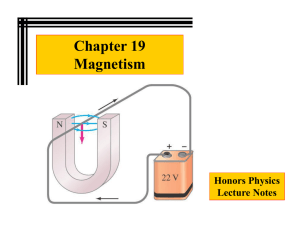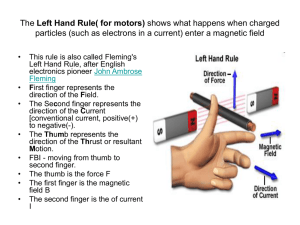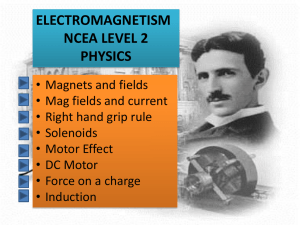Magnets_and_electrom..
advertisement
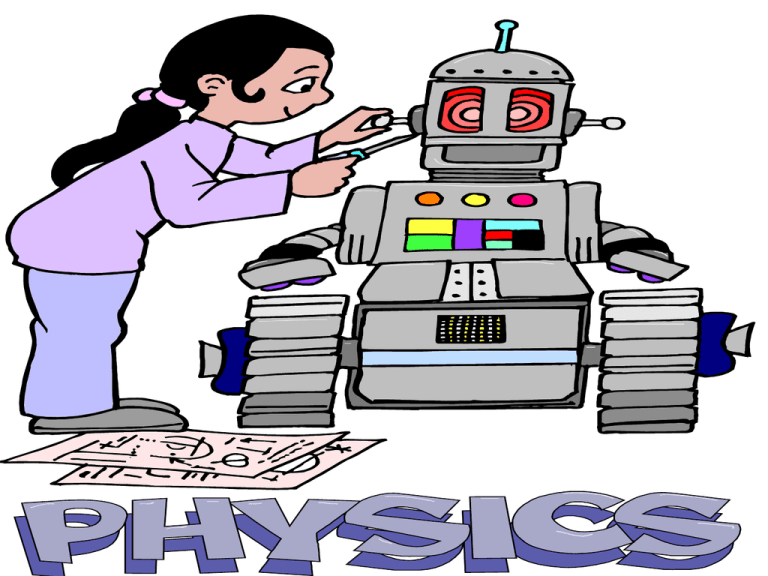
A-LEVEL PHYSICS Pupils should be able to: •Understand a magnetic field as an example of a field of force produced either by current-carrying conductors or by permanent magnets. •Represent a magnetic field by field lines. The space surrounding a magnet where a magnetic force is experienced is called a magnetic field. A magnetic field in a permanent magnet can be represented by magnetic field lines drawn so that: (i) The line gives the direction of the field at that point. (ii) The number of lines per unit cross-section area is an indication of the “strength” of the field. S Since the North Pole is repelled by the north pole of a magnet and attracted by the south, the arrows point away from the North Pole and towards the South Pole. N The field round a bar magnet varies in strength and direction from point to point, i.e. is nonuniform. S Magnetic field patterns in a N bar magnet The closer the lines, the stronger the field, and the greater the force. U-shaped magnet If two magnets are placed near each other, their magnetic fields combine to produce a single magnetic field. (A) Field pattern between two different poles (B) X In diagram A, the poles of a magnet would exert equal but opposite force on a ‘free’ pole placed at this point. At point X, the field from one magnet exactly cancels out the field from the other. X is known as NEUTRAL POINT. Field pattern between two similar poles Field due to a current in a straight wire:A conductor carrying an electric current has an associated magnetic field. Field lines For a straight wire the field lines are a series of concentric circles centred on the wire. The right - hand screw rule is a useful aid for predicting the direction of the field knowing the direction of the current. It states: If a right-handed screw moves forward in the direction of the current (convectional), then the direction of rotation of the screw gives the direction of the magnetic field lines. (Maxwell’s screw rule) Right – handed screw Straight current-carrying wire The direction of the field can also be found by using the right-hand grip rule: It states: grip the wire using the right hand with the thumb pointing in the direction of the current – the fingers then point in the direction of the field. Current direction down into slide Click here to return to the slide “field in a long solenoid” Magnetic field in a flat circular coil Current direction up out of slide Continued ----------- Magnetic field in a flat / plane circular coil N S Current direction You must note that Maxwell’s right hand screw rule applies to the field around any short section of the coil. Click here for grip rule The field pattern produced by a current flowing in a circular coil is similar to that produced by a short bar magnet, and the coil acts as if it has a N pole on one face and a S pole on the other. Click here to go back to slide “field in a long solenoid” N S When a current is passed through a long coil or solenoid, each turn acts as a single coil and produces a magnetic field. Click here to recap field in a circular coil Click here to recap right hand grip rule Together, the turns give a combined magnetic field very similar to the field around a long bar magnet. The coil behaves as if it has a N pole at one end and a S pole at the other. The right-hand grip rule can be used to work out the polarity. Click here to find out how ---- Click here to skip --- The right-hand grip rule: Imagine your righthand gripping the coil in a way that your fingers point the same way as the convectional current arrows. Your thumb then points towards the N pole. Important: reversing the direction of current flow will reverse the polarity of a solenoid. Click here to go back to “field in a long solenoid” Thumb points to N pole N S Fingers indicate convectional current direction To remember: Two rules for determining the direction of a magnetic field. (i) Right-hand grip rule for current carrying solenoid (ii) Right-hand screw rule for current carrying straight wire To see “Animated effects” on this topic, visit http://www.matter.org.uk/schools/start.html Stronger magnetic field in a long solenoid: For a solenoid of any given length, the strength of the magnetic field can be increased by: (i) Increasing the current (ii) Increasing the number of turns on the coil (iii) A soft ferromagnetic (e.g. iron) core. Solenoids of this type are called ELECTROMAGNETS, and they have many applications. This train is running at a precise distance above the track by computer-controlled electromagnets. • There is really no fundamental difference between these two ways of creating magnetic fields. • All magnetic effects are due to electric currents. • In the case of permanent magnets, the field is generated by the motion of electrons within the atoms. Each electron represents a small current as it moves around within its atom, and this current produces a magnetic field. • In the case of an electromagnet, the field is generated by the electrons from a ferrous material such as iron combining with the current to produce a stronger magnetic field. Mr Vinay Thawait M.Sc. M.Phil. P.G.C.E. Pupils should be able to: 1. Appreciate that a force may act on a current-carrying conductor placed in a magnetic field. 2. Define magnetic flux density (B) and the tesla (T). 3. Recall and use force on a current F = BIL, with directions as interpreted by Fleming’s left-hand rule. 4. Use Fleming's left-hand rule to predict the direction of forces acting on two long, straight, parallel current -carrying conductors. When a current is passed through a conductor, a magnetic field is produced. Demonstration A current carrying wire in a magnetic field. When a current-carrying conductor is placed in a magnetic field, it interacts with any other magnetic field and produces a force. N S N S Experiments shows that the force is always perpendicular to the plane which contains both the current and the external field at the site of the conductor. The conductor in this case is a length of stiff copper wire, and it is at right angles to the field provided by a U-shaped magnet. When the switch is closed, a current flows through the wire. The wire moves upwards, indicating that there is an upward force acting on it. If the direction of either the current or the field is reversed, the wire moves downwards. How can we find the direction of the force? We can predict the direction of the force using Fleming’s left-hand rule. N S thumb thrust (force) Return to learning outcome first finger field We use Fleming’s lefthand (or motor) rule to predict the direction of the force. Second finger current (convectional) If the thumb and first two fingers of the left hand are placed comfortably at right angles to each other, With the first finger pointing in the direction of the field and the second finger pointing in the direction of the current flow (convectional), then the thumb points in the direction of the thrust (force). i.e. in the direction in which motion takes place if the conductor is free to move. Points to remember, when applying the rule: 1. 2. 3. The direction of the field is from the N pole to the S pole. The direction of the current is from the positive (+) terminal of the power pack to the negative (-) terminal, i.e. convectional current direction. The rule applies only where the current and field directions are at right angles. A force still acts if the current and field directions are at some other angle, but its direction is more difficult to predict. Demonstration N Field Conductor carrying current out of screen A current carrying wire in a magnetic field. Force N Field Force Next learning outcome click S S Conductor carrying current into screen When a current carrying wire, that is free to move, is placed in a magnetic field it will experience a force and the wire will jump out of the field. The production of this force is known as the motor effect, because this force is used in electric motors. In a simple motor, a current flowing in a coil produces a magnetic field; this field interacts with a second field produced by a permanent magnet. Pupils should be able to: 1. Define magnetic flux density and the tesla. 2. Recall and use force on a current F = BIL, with directions as interpreted by Fleming’s left-hand rule. A useful way to think about a magnetic field is in terms of magnetic flux. What do we mean by flux? It is the measure of the number of magnetic field lines passing through the region. The word ‘flux’ means something that is flowing out of the north pole of a magnet and travelling around to the south pole. The lines of force can then be called flux lines. So, what is the magnetic flux density (B)? The density (strength) of a magnetic field depends on how concentrated the flux is. Where there is a lot of flux flowing, we say the field is strong. Definition: The magnetic flux density is defined as the force acting per unit current in a wire of unit length at right angles to the field. or We can say the magnetic flux density is the amount of flux flowing through unit area at a point in the field. The magnetic flux density is sometimes called flux density or magnetic induction or B-field. The symbol used for flux density is B and its unit is the Tesla ( T ). The direction of the flux density at a point is that of the tangent to the field line at the point. The magnitude of the flux density is high where the number of field lines per unit area is high. Direction of B at P Field lines are parallel and therefore B is constant, i.e. a uniform field. Field lines close together – B large B is small Click here to go back In symbols, B is defined by the equation: When a current I flows through a conductor of length l in a magnetic field, it feels a force F. The stronger the field, the greater the force. F The strength of the field B is given in equation form by: B = ------- SI unit of B is the Newton per ampere metre N A-1 m-1 . Defining Tesla? Il 1 T = 1 N A-1 m-1 . A tesla is the magnetic flux density if a wire of length 1m carrying a current of 1A has a force exerted on it of 1N in a direction at right angles to both the flux and the current. Force exerted 1N “Diagram showing A tesla” Uniform magnetic flux density B Wire of length 1m carrying a current of 1A F Rearranging the equation defining B we see that B = ------the force F on a conductor of length l, carrying a current I and lying at right angles to a magnetic Il field of flux density B, is given by: F = BIl If the conductor and field are not at right angles, but make an angle with one another the equation becomes: F = B I l sin Where, F = the force on the conductor (N) B = the magnitude of the magnetic flux density of the field (T) I = the current in the conductor (A) L = the length of the conductor (m) The force on a current depends on the angle it makes with the magnetic flux. It is clear that the force on the conductor has its maximum value when the conductor, the current and the external field are at right angles to each other ( = /2 ). and is zero when the conductor is parallel to the field ( = 0). Back to previous slide Q1. In an electric motor a rectangular coil of wire has 150 turns and is 0.20 m long and 0.12 m wide. The coil has a current of 0.26 A through it and is parallel to a field of magnetic flux density 0.36 T. Find the force exerted on the coil. Ans: 0.0187 N click here Q2. A straight wire is placed in a uniform magnetic field of magnetic flux density 0.023 T at an angle of 30° with the magnetic field. The wire carries a current of 8.6 A. Calculate the force on a 3.4 cm length of the wire. Show the direction of the force in a diagram. Ans: 0.0034 N click here Click here for next page Ans 1. Force F on 0.20 m of wire with 0.26 A through it is given by: F = BIl = 0.36 X 0.26 X 0.20 = 0.0187 N Ans 2. F = B I l sin = 0.023 X 8.6 X 0.034 X sin 30° = 0.0067 X sin 30° = 0.0034 N Force exerted If currents flows in the same direction through two parallel wires as in the diagram, there is a weak attraction between them. A Maxwell’s screw rule gives direction of field B Fleming’s left-hand rule gives direction of force Each wire experiences a force because each carries a current and each is in the magnetic field produced by the current in the other wire. Wire A produces a magnetic field whose direction is given by Maxwell’s screw rules. Knowing this direction, and the direction of current through B, the direction of the force on B can be found using Fleming’s left-hand rule. The force is to left. A similar argument shows that the force on wire A is to the right. If the currents flow in opposite directions, they repel each other. X L Y Fleming’s left-hand rule gives direction of force F B Maxwell’s screw rule gives direction of field The ampere is the constant current which, when flowing through two infinitely long, straight, parallel conductors which have negligible areas of cross-section and are 1 metre apart in a vacuum, causes each conductor to exert a force of 2 X 10 –7 N on each metre of the other. Like currents attract and unlike currents repel. Forces between current-carrying conductors provide the basis of the definition of the ampere. 1. Magnetic fields are produced by permanent magnets and by electric currents. This can be represented by lines of force. 2. When a current flows across a magnetic field, there is an interaction between the two fields. 3. The direction of the resulting force is given by Fleming’s left-hand rule. 4. The strength of a magnetic field is known as the magnetic flux density. 5. The force on a current-carrying conductor in a magnetic field is given by: F = BIl 6. and F = B I l sin There is a force between two parallel currents, and this is used as the basis of the definition of the ampere. Mr Vinay Thawait M.Sc. M.Phil. P.G.C.E.

